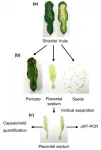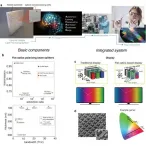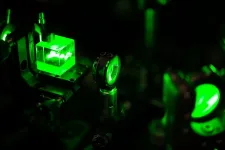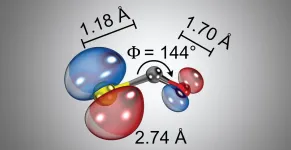Plants as protein factories: Antioxidant boosts the yield of valuable biologics
Research team at University of Tsukuba finds spraying leaves with vitamin C prevents cell death and enhances production of high-value pharmaceutical proteins in plants
2021-03-09
(Press-News.org) Tsukuba, Japan - Producing high-value pharmaceutical proteins in plants--sometimes called "molecular pharming"--offers advantages over some other manufacturing methods, notably the low cost and ease of scaling up production to meet demand. But expressing large quantities of "foreign" proteins in plants can also sometimes lead to problems, such as dehydration and premature cell death in the leaves.
Now a team led by Professor Kenji Miura of the University of Tsukuba has discovered that spraying leaves with high concentrations of the antioxidant ascorbic acid (vitamin C) can increase protein production three-fold or even more. They recently published their findings in Plant Physiology.
The team worked with a close relative of tobacco, Nicotiana benthamiana, which is widely used for this type of application as the plants grow well in greenhouses and it is relatively straightforward to introduce foreign genes. The researchers induced the leaves to produce new proteins by a process known as agro-infiltration: the leaves are injected with bacteria called Agrobacterium that carry the DNA encoding the proteins of interest into plant cells. The leaf cells decode the DNA and use it to make the new proteins.
While some foreign proteins cause few problems for the plant cells, others can lead to side-effects that seem to be caused by an excess of damaging reactive oxygen species. Applying ascorbic acid as an antioxidant counteracts the harmful effects and allows substantially higher rates of protein production.
"We tested the method with several different types of proteins," says Professor Miura. "We used green fluorescent protein (a common tool in the lab) and two human proteins, called Cul1 and an F-box protein. Spraying the leaves with ascorbic acid made a surprisingly big difference, but only when we applied high concentrations of the antioxidant. It seems that ascorbic acid prevents cell death and also reduces the breakdown of the foreign proteins, so the yield is higher."
The team went on to successfully produce both the heavy chain and light chain of an antibody protein. They showed that the chains produced in leaves assembled correctly into a functional antibody (comprising two heavy and two light chains), and ascorbic acid did not interfere with its immunological properties.
"We are delighted by our results," says Professor Miura. "As this method of spraying the leaves is so simple, we expect it can be widely adopted and should help to improve the production of many types of valuable proteins for research and medical applications."
INFORMATION:
The article, "Prevention of necrosis caused by transient expression in Nicotiana benthamiana by application of ascorbic acid", was recently published in Plant Physiology at doi.org/10.1093/plphys/kiab102.
[Attachments] See images for this press release:
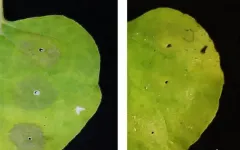
ELSE PRESS RELEASES FROM THIS DATE:
2021-03-09
The fossil in question is that of an oviraptorosaur, a group of bird-like theropod dinosaurs that thrived during the Cretaceous Period, the third and final time period of the Mesozoic Era (commonly known as the 'Age of Dinosaurs') that extended from 145 to 66 million years ago. The new specimen was recovered from uppermost Cretaceous-aged rocks, some 70 million years old, in Ganzhou City in southern China's Jiangxi Province.
"Dinosaurs preserved on their nests are rare, and so are fossil embryos. This is the first time a non-avian dinosaur has been found, sitting on a nest of eggs that preserve embryos, in a single ...
2021-03-09
For the first time, two researchers--one from the University of Copenhagen and the other from Columbia University--have accurately dated the arrival of the first herbivorous dinosaurs in East Greenland. Their results demonstrate that it took the dinosaurs 15 million years to migrate from the southern hemisphere, as a consequence of being slowed down by extreme climatic conditions. Their long walk was only possible because as CO2 levels dropped suddenly, the Earth's climate became less extreme.
A snail could have crawled its way faster. 10,000 km over 15 million years--that's how long it took the first herbivorous dinosaurs to make their way from Brazil and Argentina all the way to East Greenland. This, according to a new study by Professor ...
2021-03-09
Chili peppers (Capsicum spp.) are an important spice and vegetable that supports food culture around the world, whose intensity of its pungent taste is determined by the content of capsicumoids. However, the content of capsicumoids varies depending on the variety and is known to fluctuate greatly depending on the cultivation environment. This can be a big problem in the production, processing and distribution of peppers where sweet varieties can be spicy and highly spicy varieties are just only mildly spicy. It is thought that changes in the expression of multiple genes involved in capsaicinoid biosynthesis are involved in such changes in pungent taste ...
2021-03-09
When something bad happens to a child, the public and policy response is swift and forceful.
How could this have happened?
What went wrong?
What do we do to make sure it never happens again?
When a family becomes erroneously or unnecessarily enmeshed in the child welfare system, that burden is largely invisible - a burden borne mostly by the family itself.
In both situations, the fault for the systemic failure is often placed on the caseworker - overburdened, under-resourced, and forced to make quick and critical judgments about the risk ...
2021-03-09
In a new paper published in Light Science & Application, the group led by Professor Andrea Fratalocchi from Primalight Laboratory of the Computer, Electrical and Mathematical Sciences and Engineering (CEMSE) Division, King Abdullah University of Science and Technology (KAUST), Saudi Arabia, introduced a new patented, scalable flat-optics technology manufactured with inexpensive semiconductors.
The KAUST-designed technology leverages on a previously unrecognized aspect of optical nanoresonators, which are demonstrated to possess a physical layer that is completely equivalent to a feed-forward deep neural network.
"What we have achieved," explains Fratalocchi, "is a ...
2021-03-09
Obtaining a precise understanding of magnetic structures is one of the main objectives of solid-state physics. Significant research is currently being undertaken in this field, the aim being to develop future data processing applications that use tiny magnetic structures as information carriers. Physicists at Johannes Gutenberg University Mainz (JGU) and the Helmholtz Institute Mainz (HIM) recently presented a new method for investigating magnetic structures combining two different techniques. This allows to measure and map the magnetization as well as the magnetic ...
2021-03-09
For ice, so-called "surface melting" was postulated as early as the 19th century by Michael Faraday: Already below the actual melting point, i.e. 0 °C, a thin liquid film forms on the free surface because oft he interface between ice and air. Scientists led by Markus Mezger, group leader at the Max Planck Institute for Polymer Research (department of Hans-Jürgen Butt) and professor at the University of Vienna, have now studied this phenomenon in more detail at interfaces between ice and clay minerals.
In nature, this effect is particularly interesting in permafrost soils - i.e. soils that are permanently frozen. About a quarter of the land area ...
2021-03-09
The efficient provision of medical care is integral to society. Over time, the healthcare industry has tapped into modern technology in order to keep up its quality of service. This has, unsurprisingly, led to huge volumes of patient data. But it's not just patients whose data need to be stored; doctors, physicians, clinical staff, and even smart wearable gadgets are contributing to what is coming to be known as "healthcare big data."
Big data analytics (BDA), which involves the use of special design architectures to manage, store, and analyze complex data, is an important tool in healthcare. But it is hard to implement, owing to its high failure rate, resource-intensive process, and--most importantly--a lack of a clear guideline to aid practitioners. ...
2021-03-09
Light microscopes have revolutionized our understanding of the microcosmos, but their resolution is limited to about 100 nanometers. To see how molecules bond, break, or change their structure, we need at least 1000 times better resolution.
Laser induced electron diffraction (LIED) is a technique which allows to pinpoint the individual atoms inside a single molecule, and to see where each atom moves when the molecule undergoes a reaction. This technique proved to be an amazing tool for the imaging molecules, such as water, carbonyl sulfide or carbon disulfide. However, using a strong laser field to generate the electron diffraction presented challenges in retrieving the exact structure, since the structural resolution depended on exact knowledge of the ...
2021-03-09
New Haven, Conn. -- Mailing a package of SARS-CoV-2 tests to every household in America and asking people to use them once a week could greatly reduce total infections and mortality at a justifiable cost, a new study led by the Yale School of Public Health finds.
The research, published today in Annals of Internal Medicine, considers rapid antigen tests that warn people, in real-time, that they are potentially contagious and that they should isolate themselves before unknowingly spreading the disease to others. Investigators, led by Professor A. David Paltiel, assembled data on the epidemiology of SARS-CoV-2 and the natural history of COVID-19. They then used a mathematical model to estimate how many infections, hospitalizations, and deaths could be averted - and at what cost - by providing ...
LAST 30 PRESS RELEASES:
[Press-News.org] Plants as protein factories: Antioxidant boosts the yield of valuable biologics
Research team at University of Tsukuba finds spraying leaves with vitamin C prevents cell death and enhances production of high-value pharmaceutical proteins in plants


